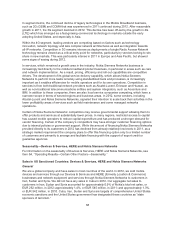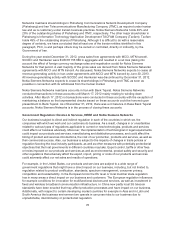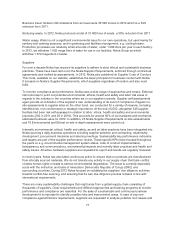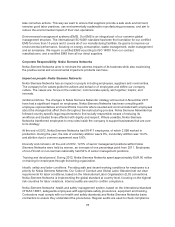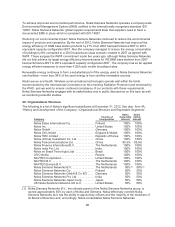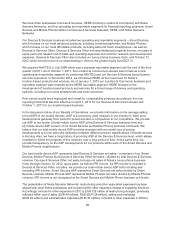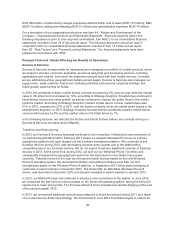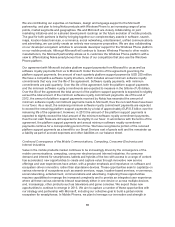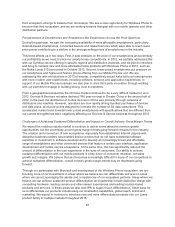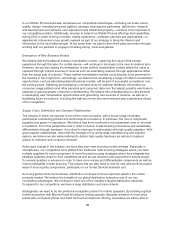Nokia 2012 Annual Report Download - page 79
Download and view the complete annual report
Please find page 79 of the 2012 Nokia annual report below. You can navigate through the pages in the report by either clicking on the pages listed below, or by using the keyword search tool below to find specific information within the annual report.take corrective actions. This way we want to ensure that suppliers provide a safe work environment,
exercise good labor practices, use environmentally sustainable manufacturing processes, and aim to
reduce the environmental impact of their own operations.
Environmental management systems (EMS). Our EMS is an integral part of our common global
management structure. The international ISO14001 standard has been the foundation for our certified
EMS for more than 15 years and it covers all of our manufacturing facilities. Its goal is to improve our
environmental performance, focusing on energy consumption, waste management, water management
and air emissions. We require a certified EMS according to ISO 14001 from our contract
manufacturers, and a certified EMS from all our direct suppliers.
Corporate Responsibility: Nokia Siemens Networks
Nokia Siemens Networks aims to minimize the adverse impacts of its business while also maximizing
the positive social and environmental impacts its products can have.
Impact on people: Nokia Siemens Networks
Nokia Siemens Networks has an impact on people including employees, suppliers and communities.
The company’s five values guide the actions and behavior of employees and define our company
culture. The values are: focus on the customer; communicate openly; win together; inspire; and
innovate.
Global workforce. The changes to Nokia Siemens Networks’ strategy announced in November 2011
have had a significant impact on employees. Nokia Siemens Networks has been consulting with
employee representatives and local Works Councils where needed and communicated with employees
about the changes that affect them throughout the restructuring process. Nokia Siemens Networks has
followed country-specific legal requirements to find socially responsible means of reducing its
workforce and treated those affected with dignity and respect. Where possible, Nokia Siemens
Networks transferred employees to new roles inside the company to support businesses that are core
to its strategy.
At the end of 2012, Nokia Siemens Networks had 58 411 employees, of which 2 098 worked in
production. During the year, the rate of voluntary attrition was 9.9%, involuntary attrition was 14.2%
and attrition due to common agreement was 5.8%.
Diversity and inclusion. At the end of 2012, 12.5% of senior management positions within Nokia
Siemens Networks were held by women, an increase of one percentage point from 2011. Employees
of non-Finnish or non-German nationality held 54% of senior management positions.
Training and development. During 2012, Nokia Siemens Networks spent approximately EUR 50 million
on training for employees through its training organization.
Health, safety and labor conditions. Providing safe and decent working conditions for employees is a
priority for Nokia Siemens Networks. Our Code of Conduct and Global Labor Standard set out clear
requirements for labor conditions, based on the International Labor Organisation (ILO) conventions.
Nokia Siemens Networks is implementing the global standard at country level, focusing on the highest
risk countries for labor violations. Internal audits are used to confirm compliance.
Nokia Siemens Networks’ health and safety management system, based on the international standard
OHSAS 18001, safeguards employees with appropriate safety procedures, equipment and training.
Contractors must comply with our health and safety standards and Nokia Siemens Networks trains
contractors to ensure they understand the procedures. Regular audits are used to check compliance.
78


